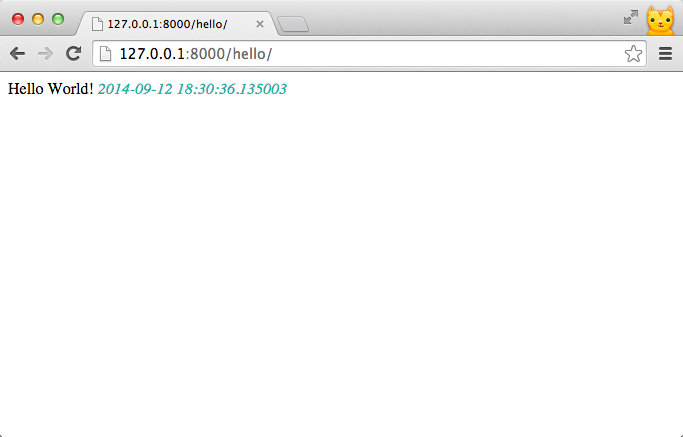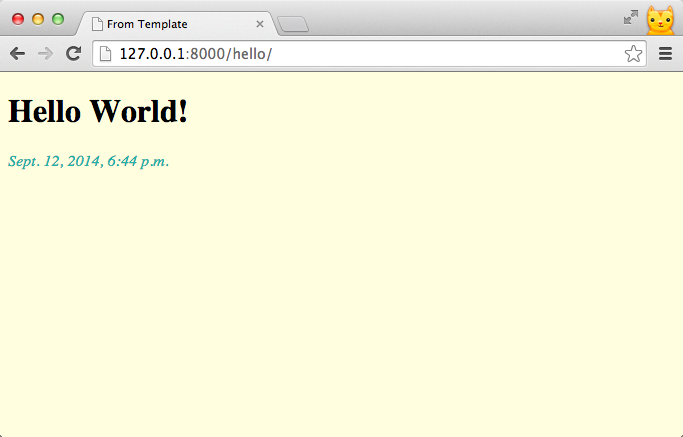Templates
最后更新于:2022-04-01 23:37:22
# Templates
### 加上 HTML / CSS & 動態內容
上一章的例子,只是很簡單的顯示一行字串。讓我們加上一些 HTML/CSS 美化網頁,並動態顯示每次進來這個頁面的時間:
~~~
# trips/views.py
from datetime import datetime
from django.http import HttpResponse
def hello_world(request):
output = """
Hello World! {current_time}
""".format(current_time=datetime.now())
return HttpResponse(output)
~~~
1.
**多行字串:**
`"""..."""` 或是 `'''...'''` (三個雙引號或三個單引號) 是字串的多行寫法,這裡我們使用它表達 HTML,並維持原有的縮排。
1.
**顯示目前時間:**
為了顯示動態內容,我們 import [datetime](https://docs.python.org/3/library/datetime.html) 時間模組,並用`datetime.now()`取得現在的時間。
1.
**字串格式化:**
使用 [format()](https://docs.python.org/3/library/string.html#string-formatting) 格式化字串,將 datetime.now() 產生的值,代入 `{current_time}` 在字串中的位置。
現在啟動 web server ,連至 [http://127.0.0.1:8000/hello/](http://127.0.0.1:8000/hello/) 後,會發現網頁不再是純文字。除了加上了一些樣式外,也會顯示當下的時間。
*你可以重新整理網頁,試試看時間有沒有改變*

### 第一個 Template
在前一個例子,我們把 HTML/CSS 放在 View function 裡。但在實務上,我們會將前端的程式碼獨立出來,放在 templates 資料夾裡。不僅增加可讀性,也方便與設計師或前端工程師分工。
### Template 資料夾
首先建立 Template 資料夾。開啟終端機 *(如果不想關閉 web server,可以再開新一個新的終端機視窗)*,並確認目前所在位置為 `djangogirls/mysite/`。
新增一個名為 `templates` 的資料夾`:
~~~
mkdir templates
~~~
### 設定 Templates 資料夾的位置
建立好資料夾以後,我們需要修改`mysite/settings.py`,加上`TEMPLATE_DIRS`:
~~~
# mysite/settings.py
TEMPLATE_DIRS = (
os.path.join(BASE_DIR, 'templates').replace('\\', '/'),
)
~~~
### 建立第一個 Template
新增檔案 `templates/hello_world.html` ,並將之前寫在 View function 中的 HTML 複製到 `hello_world.html`
~~~
mysite
├── mysite
├── templates
│ └── hello_world.html
├── trips
└── manage.py
~~~
為了區別,我們做了一些樣式上的調整:
~~~
I come from template!!
`*`}}` 是在 Django Template 中顯示變數的語法。
*其它 Django Template 語法,我們會在後面的章節陸續練習到*。
### render
最後,將 **hello_world** 修改如下:
~~~
# trips/views.py
from datetime import datetime
from django.shortcuts import render
def hello_world(request):
return render(request,
'hello_world.html',
{'current_time': datetime.now()})
~~~
我們改成用 `render` 這個 function 產生要回傳的 HttpResponse 物件。
這次傳入的參數有:
- **request** -- HttpRequest 物件
- **template_name** -- 要使用的 Template
- **dictionary** -- 包含要新增至 Template 的變數
**Render** :產生 HttpResponse 物件。
[render(request, template_name, dictionary)](https://docs.djangoproject.com/en/1.7/topics/http/shortcuts/#render)
#### 大功告成
HTML 程式碼獨立成 Template 後,程式也變得簡潔許多了。
重新載入 [http://127.0.0.1:8000/hello/](http://127.0.0.1:8000/hello/),你會發現畫面有了小小的改變:

';